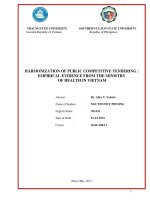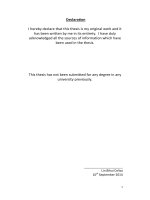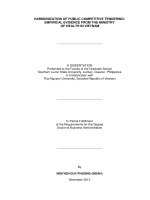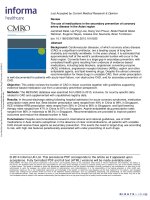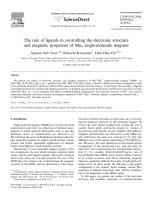The primacy of vision in virgils aeneid
Bạn đang xem bản rút gọn của tài liệu. Xem và tải ngay bản đầy đủ của tài liệu tại đây (532 KB, 272 trang )
the primacy of vision in virgil’s Aeneid
THIS PAGE INTENTIONALLY LEFT BLANK
n
the primacy
of vision in
virgil’s Aeneid
n
Riggs Alden Smith
university of texas press
austin
copyright © 2005 by the university of texas press
All rights reserved
Printed in the United States of America
First edition, 2005
Requests for permission to reproduce material from this work
should be sent to Permissions, University of Texas Press,
P.O. Box 7819, Austin, TX 78713–7819.
The paper used in this book meets the minimum requirements of
ansi/niso z39.48–1992 (r1997) (Permanence of Paper).
library of congress cataloging-in-publication data
Smith, Alden.
The primacy of vision in Virgil’s Aeneid / Riggs Alden Smith.— 1st ed.
p.
cm.
Includes bibliographical references and index.
isbn 0-292-70657-x (alk. paper)
1. Virgil. Aeneis. 2. Aeneas (Legendary character) in literature.
3. Epic poetry, Latin—History and criticism. 4. Visual perception in
literature. 5. Art and literature—Rome. 6. Visions in literature.
7. Rome—In literature. 8. Vision in literature. I. Title.
pa6825.s63 2005
873'.01—dc22
2004028381
n
Dianae,
meae uitae,
forsan et haec olim meminisse iuuabit.
THIS PAGE INTENTIONALLY LEFT BLANK
Contents
n
preface and acknowledgments ix
text and art acknowledgments xiii
abbreviations xv
chapter 1 Prophaenomena ad Vergilium 1
Theory 5
Theoria 7
Ante ora patrum 12
The Scope of the Argument 21
chapter 2 Ruse and Revelation: Visions of the Divine and
the Telos of Narrative 24
Seen/Unseen 26
Gods Revealed 36
A God in the Midst 51
chapter 3 Vision Past and Future 60
Hector and the Penates 61
Hindsight to Foresight: Andromache and Aeneas 71
Imago Creusae 77
Vision and Temporal Modality in Aeneas’ Katabasis 82
Site/Sight of Rome 90
Conclusion 95
chapter 4 Hic amor: Love, Vision, and Destiny 97
Aliud genus officii: Vision and the Second Favor 98
vii
the primacy of vision in virgil’s Aeneid
Viewpoints of Departure: Deception, Vision, and the
Separation of Dido and Aeneas 106
Fixos Oculos 115
Lauiniaque uenit 121
Conclusion 126
chapter 5 Vidi, Vici: Vision’s Victory and the Telos of
Narrative 128
Failure of Rhetoric (Part 1): Effete oratores 133
Drances and Turnus: Opposing Visions 139
Hercules and Cacus: Light, Darkness, and Diction 147
Failure of Rhetoric (Part 2): The Futility of Battlefield
Entreaty in Books 10–12 152
Failure of Rhetoric (Part 3): Sight Makes Right and the
Aeneid’s Finale 159
chapter 6 Conclusion: Ante ora parentum 176
notes 183
bibliography 223
subject index 237
index locorum 247
viii
Preface and Acknowledgments
n
My desire to consider vision in the Aeneid is in part derived from an interest
in ancient art that I first cultivated at the Intercollegiate Center for Classical Studies in Rome, a program that I attended as an undergraduate under
Mary Sturgeon and Fred Albertson. My own research about ecphrasis, which
I considered in my first book, also influenced my consideration of the topic
of vision in the Aeneid. Based on my preliminary studies, I gave papers at
Princeton, Yale, Wesleyan, Columbia, Notre Dame of Maryland, Austin College, Texas Tech, Monmouth College, the University of Texas at Austin, the
University of Vermont, and later, at Penn and Colorado. While only a little
of the specific content of any of these lectures has come into this book,
the development of my methodology is owed to them, and I wish to thank
each of those departments for a warm reception and lively discussion. To
Denis Feeney, David Quint, Jim O’Hara, Gareth Williams, Sister Thérèse
Dougherty, Robert Cape, Edward George, Karl Galinsky, Tom Sienkewicz,
Phil Ambrose, Joe Farrell, and Peter Knox, and all their colleagues, I express
my gratitude here.
I wish to thank the committees for research grants and sabbaticals at Baylor University, for without a respite from my duties at Baylor and without
adequate financial support I could not have undertaken this project; special
thanks to Wallace Daniel, Thomas Hibbs, David Jeffrey, Donald Schmeltekopf, and Robert Sloan for support, encouragement, and vision. I would also
like to thank Tommye Lou Davis for taking over as acting chair of the department in my absence.
I wrote this book in Philadelphia, where I used the resources of the University of Pennsylvania’s Van Pelt Library. I wish to thank the kind librarians
there, as well as those of Moody Library at Baylor and of the Classics Library
ix
the primacy of vision in virgil’s Aeneid
at the University of Texas at Austin (particularly Bonnie) for timely assistance throughout this project. I thank my mother, too, for allowing me to
stay with her in New Hope, Pennsylvania, so that I could take advantage of
her home’s proximity to the Penn campus. My own gentle colleagues at Baylor have been of great support and have offered numerous editorial insights.
I acknowledge all of them for encouragement, among whom are Tommye
Lou Davis, Daniel Eady, Chris Flood, Kevin Hawthorne, Carol King, John
Nordling, and Amy Vail. Those who read and edited sizeable portions of the
manuscript include Antony Augoustakis, Julia Dyson, Jeff Fish, Brent Froberg, Aaron Johnson, and John Thorburn. Megan Mauldin, my assistant in
the University Scholars Program, was of great help in the final stages of this
project. I also thank Richard Duran for insightful suggestions and Paulette
Edwards for logistical support. My colleagues’ observations have much improved this project.
My former students, too, have offered comments, suggestions, and encouragement. Among many I would like to thank Angeline Chiu, Jason
Gajderowicz, Dan Hanchey, Dustin Heinen, Jeff Hunt, Leslie Hutton, Sean
Mathis, Amanda Seamans-Mathis, and Michael Sloan. My current students,
some of whom have studied Virgil with me and have read a previous version of this book, offered several insights. These students are Katie Calloway,
Rosalyn Chan, Jonathan Dunbar, Lesley-Anne Dyer, Cory Elliott, Erik Ellis,
Lindsay Fuller, Martin Gallagher, Karen Kelly, Christin Laroche, Rachel
Miller, Emily Nicholson, Dionne Peniston, Katie Smith, Candace Spain, and
Becky Tompkins.
I want also to thank other colleagues and friends who have assisted me in
various different ways on this project: Michael Appleby, David Armstrong,
Olof Brandt, Fred Crosson, Roald Docter, Carlo Gasparri, Timothy Johnson,
Eric Kyllo, Paolo Liverani, Paul McCoy, Jan Stubbe Østergaard, Piergiacomo
Petrioli, Steve and Brenda Ramer, David White, Orley Lindgren and Katriona
Munthe-Lindgren (for a salutary retreat in Leksand amidst the chaos), and la
familia Scariglia, for a similar retreat in Cumae. At Leksand I had the pleasure to meet Pia and Jan Thunholm. I wish to express my appreciation to
Jan, whose beautiful linocut adorns this book’s cover. Professor Bettina Bergmann of Mt. Holyoke was especially helpful in securing for me the photograph of Helen from the House of the Tragic Poet. I thank her for allowing
me to use her copy of this photograph. To Philip Lockhart, Professor Emeritus, Dickinson College, I can barely begin to express my deepest gratitude.
Phil’s constant advice and encouragement and gentleness have shaped and
guided me throughout my career.
As my work developed, I corresponded several times with Martin Jay,
x
Preface and Acknowledgments
Sidney Hellman Ehrman Professor of History at the University of California at Berkeley, whom I had the opportunity to meet when he was a fellow
at the Institute for Advanced Studies at Princeton; he read an early draft of
the first chapter and offered valuable insights. I also discussed the methodological aspects of this book with Lowell Edmunds, Professor of Classics at
Rutgers, whose feedback on the first chapter was also helpful. I would especially like to acknowledge William S. Anderson, Graduate Professor of Classics at Berkeley. Bill read an early draft of the complete manuscript, causing
me to reshape and clarify my arguments. I thank him much for his honest
and constructive criticism and warm encouragement.
I would also like to thank the anonymous readers of University of Texas
Press. I now know who these kind individuals are and I owe them much for
their valuable comments. I also offer grateful acknowledgment to Jim Burr,
Classics and History Editor; Nancy Moore; and the editorial staff of the University of Texas Press. It has been a true pleasure to work with all of them.
Finally, I want to thank some very special people. I thank first Thelma
Mathews, my wonderful assistant in the Classics Department at Baylor, who
facilitated many aspects of the production of this manuscript, from photocopying to mailings. To Jenny Cook, my assistant in the University Scholars Program and stalwart fellow laborer on this project, I owe more than I
can possibly say here. She put in many late hours reading and rereading my
work, offering numerous good suggestions and insightful comments. She is a
superior editor, a remarkable proofreader, and a true friend. I thank my children, Katie, Harry, Ben, and Rachel, for their patience and encouragement
throughout this project. Finally, to Diane, my wife and hero, for whom I am
truly thankful and without whom not only this project but every aspect of
my life would not be possible, I wish to express eternal, heartfelt gratitude.
I dedicate this book to her.
xi
THIS PAGE INTENTIONALLY LEFT BLANK
Text and Art Acknowledgments
n
The following was provided by Jan Thunholm: Cover illustration, Aeneas
and Turnus: The Final Duel.
The following was provided by the Vatican Museum, with special thanks to
Paolo Liverani, Director of the Vatican Museum, and to Padre Raffaele Farina, Prefetto della Biblioteca Apostolica Vaticana:
Figure 1.1: Aeneas amidst the Storm. From the fifth-century Codex
Vergilianus Romanus. Vatican Museum.
The following were provided by Art Resource, in cooperation with the
Museo Nazionale, Naples:
Figure 4.1: Medea Meditating on Killing Her Children. Pompeian
Fresco. Museo Archeologico Nazionale, Naples.
Figure 4.2: Phaedra and Maid Servant. Pompeian Fresco. Museo
Archeologico Nazionale, Naples.
Figure 5.1: Theseus Having Slain the Minotaur. Pompeian Fresco.
Museo Archeologico Nazionale, Naples.
The following was provided by Dr. Bettina Bergmann from her personal
collection:
Figure 4.3: Helen Embarking. Fresco from the House of the Tragic Poet.
Museo Archeologico Nazionale, Naples.
xiii
the primacy of vision in virgil’s Aeneid
The following was provided by Art Resource, in cooperation with the Berlin
Staatlandes Museum:
Figure 4.4: Helen in Her Boudoir. Red-figured Attic drinking cup (kylix)
from Nola, 450–440 bc. Side B. Berlin Staatlandes Museum. Photo:
Johannes Laurentius.
All Latin citations of Virgil are taken from the edition of R. A. B. Mynors,
ed., P. Vergili Maronis Opera (Oxford, 1969). Used by permission of Oxford
University Press.
All English translations of Virgil are those of Allen Mandelbaum, tr., The
Aeneid of Virgil (New York, 1971; rpt. 1981). Used by permission of Bantam
Books, a division of Random House, Inc.
xiv
Abbreviations
n
ACS
Acta Ant. Hung
Aen.
AFL Nice
AHB
AJA
AJP
Anth. Pal.
Appian Bell Civ.
ARCA
Arg
BMCR
CA
Cass. Dio
Cat
CJ
Conf.
CQ
CR
CW
Dial. Mort.
DK
DRN
Enc. Virg.
G.
American Classical Studies
Acta Historica Academiae Scientiarum Hungaricae
Aeneid
Annales de la Faculté de Lettres et Sciences Humaines
de Nice
Ancient History Bulletin
American Journal of Archaeology
American Journal of Philology
Anthologia Palatina
Appian Bellum Civile
Classical and Medieval Texts, Papers and Monographs
Argonautica
Bryn Mawr Classical Review
Classical Antiquity
Cassius Dio
In Catilinam
Classical Journal
Confessiones
Classical Quarterly
Classical Review
Classical Weekly
Dialogi Mortuorum
Diels-Kranz
De Rerum Natura
Enciclopedia Virgiliana
Georgics
xv
the primacy of vision in virgil’s Aeneid
G&R
HSCP
ICS
Il.
Inst.
JRA
JRS
Lewis and Short
LIMC
M.
Od.
OED
OLD
PCPhS
Pliny NH
PVS
REL
RG
RhM
TAPA
TLL
WS
YCS
Greece and Rome
Harvard Studies in Classical Philology
Illinois Classical Studies
Iliad
Institutio Oratoria, Quintilian
Journal of Roman Archaeology
Journal of Roman Studies
Lewis and Short, A Latin Dictionary
Lexicon Iconographicum Mythologiae Classicae
Mandelbaum
Odyssey
Oxford English Dictionary
Oxford Latin Dictionary
Proceedings of the Cambridge Philological Society
Pliny Naturalis Historia
Proceedings of the Virgil Society
Revue des Études Latin
Res Gestae
Rheinisches Museum
Transactions of the American Philological Association
Thesaurus Linguae Latinae
Wiener Studien
Yale Classical Studies
Virgilian commentaries will be referred to by the editor’s last name. If the
editor has written more than one commentary, the last name and year of
publication will be given.
xvi
the primacy of vision in virgil’s Aeneid
THIS PAGE INTENTIONALLY LEFT BLANK
chapter 1
Prophaenomena ad Vergilium
n
Much have I travell’d in the realms of gold,
And many goodly states and kingdoms seen;
Round many western islands have I been
Which bards in fealty to Apollo hold.
Oft of one wide expanse had I been told
That deep-brow’d Homer ruled as his demesne;
Yet did I never breathe its pure serene
Till I heard Chapman speak out loud and bold:
Then felt I like some watcher of the skies
When a new planet swims into his ken;
Or like stout Cortez when with eagle eyes
He star’d at the Pacific—and all his men
Look’d at each other with a wild surmise—
Silent, upon a peak in Darien.
john keats 1
‘‘Eagle eyes’’ is an expression often applied to people of uncommon perception and piercing vision, those able to see things hard to perceive. Throughout ‘‘On First Looking into Chapman’s Homer,’’ Keats’ manipulation of vision does more than create lingering images; it offers a kind of theoretical
point of access for the poem. The sightless Homer now becomes tactile: his
realm visible, its aura breathable, and his voice, through Chapman, finally
audible. Chapman’s translation of Homer gives the reader a new vision of the
poet, allowing Keats to extol and describe through a strikingly visual simile.
Keats’ poem celebrates vision, emphasizing both acquisition of knowledge
1
the primacy of vision in virgil’s Aeneid
and the response of wonder. Homer’s blindness contrasts with Cortez and
his men, who marvel at the spectacular sight before them. These different
perspectives converge to create for the reader a rich literary vista.
Keats’ use of vision, therefore, is not a mere matter of perspective but a
subjective experience informed by the intertextual resonance with Chapman’s Homer. This subjectivity is not defined simply as a character’s subjective posture, that is, the relative point of view of a character, but rather
as the poet’s ability to exploit his characters’ vantage points, as Keats does
with Cortez. Vantage point is thus linked to the notion of subjectivity.
Richard Heinze 2 and William Anderson 3 have both addressed subjectivity
in Virgil, and Brooks Otis 4 has devoted an entire chapter to Virgil’s subjective style, explaining that Virgil narrates through his characters, identifying with their perspective: ‘‘Virgil is constantly conscious of himself inside
his characters. He thinks through them and for them.’’ 5 While this aspect of
Virgil’s style offers an interesting line of inquiry and will generally inform
my discussion, the overall scope of this study is broader.
‘‘Focalization,’’ a component of the theoretical framework of the late Don
Fowler, has offered Virgilian scholarship a point of departure for the study
of issues related to point of view.6 This mode of interpretation, formulated
by the French narratologist Gérard Genette,7 has been profitably applied to
Polybius,8 Lucan,9 Livy,10 and Ovid 11 in recent Latin studies. Behind Genette’s
theory of narratology lies the question ‘‘Who sees?’’ In this book, I wish to
ascertain how vision functions within the Virgilian narrative by asking not
only the question ‘‘Who sees?’’ but also ‘‘What is seen?’’ and ‘‘How does Virgil
employ vision and visual perspectives to suggest the thoughts and motives
of his characters?’’
The importance of vision in the Aeneid increases as the poem approaches
its telos. That telos is ultimately Rome’s foundation, which begins, symbolically, with Aeneas’ killing of Turnus. I will seek to connect vision to
that telos, considering how information gathered visually differs from that
gathered aurally. Thus I will contrast visual and verbal modes of communication and perception that anticipate the poem’s telos.
A quarter of a century ago, Michael Putnam made the powerful observation that throughout the Aeneid, ‘‘words are replaced more regularly by
deeds.’’ 12 Virgil’s poem obviously includes a number of speeches, a necessary form of presenting and garnering information in epic narrative. In
the Aeneid, however, speeches are also used to counter another method
of information gathering that emerges within the text, namely, vision.13 In
the final analysis, Virgil contrasts oratory with vision in such a way that,
after continuous tension between rhetoric and vision throughout the poem,
2
Prophaenomena ad Vergilium
vision ultimately triumphs as the dominant means of communication and
perception.14
This tension between sight and speech reflects the time when Virgil composed the Aeneid, a period situated between the waning influence of the art
of rhetoric in the Roman Republic and the waxing influence of images in the
new empire.15 Paul Zanker and Karl Galinsky have shown that visual messages played a major role in shaping Augustan culture. Zanker notes that
images primarily serve the creation of a new mythology of Rome.16 Galinsky furthers this discussion by showing how the use of images during the
Augustan ‘‘renaissance’’ of art and literature reflected the unique environment of the pax Augusta. Yet as Galinsky has convincingly shown, these
images were not mere propaganda.17 The Forum Augustum served as a cultural center, the approximate equivalent of the Athenian acropolis.18 Shortly
after Virgil’s death, the Ara Pacis would proclaim the Augustan peace while
also suggesting a reformulation of the concordia ordinum.19 Augustus’ completion of the Theater of Marcellus did not merely continue Julius Caesar’s
building program, but it also gave tangible evidence of the first emperor’s
interaction with the populace.
In Virgil’s day, Augustan architecture and other artistic expression redefined the Roman world.20 This development is also reflected in poetry. For
example, Karl Galinsky and Michael Putnam have each fruitfully compared
the content of Horace’s Odes 4 to that of the Ara Pacis.21 Tibullus’ topographical poem, too, reveals how a poet can overlay geographical and historical details to suggest the importance of the urbs as the setting of a love
affair (2.5).22 Such examples demonstrate the Augustan texts’ heightened emphasis on visual themes, particularly those tied to a new understanding of
the world as reflected in imperial building. Structures such as the Palatine
temple of Apollo 23 and art objects such as the Augustus of Prima Porta 24
acted as bearers of messages that reflected the highly visual aspects of Augustan society. Virgil’s use of vision, therefore, ultimately signals a communication shift that the social climate of Augustan Rome had already begun
to embrace.
Based on these observations, for the current undertaking I will establish
two ideas as operating premises:
1.
2.
Within the context of the decline of Republican rhetoric, the
Augustan age was peculiarly rife with and indebted to visual
conveyance of ideas (Zanker’s and Galinsky’s overarching
contribution).
For characters in Virgil’s Aeneid, vision emerges as the most
3
the primacy of vision in virgil’s Aeneid
prominent way of constructing and interpreting reality. This is
particularly true of Aeneas, who reacts to visual stimuli more
efficiently than he does to verbal requests.
On the basis of these premises, I will argue that Virgil’s poem encompasses
a subtle shift from rhetoric to vision as the primary means of conveying and
gathering information. This shift is important because it informs Aeneas’ decisions in the epic, from leaving Dido to killing Turnus. To support and explicate this thesis, I will apply the philosophical formulations of the twentiethcentury French philosopher Maurice Merleau-Ponty to Virgil’s principal
character, Aeneas.25 My use of Merleau-Ponty is not meant to introduce a
tight phenomenological approach to reading. Others such as Gadamer and
Ingarden 26 have done this successfully, within the contexts of their hermeneutic and structuralist systems.
Ingarden’s analysis of the literary work of art’s anatomy, its essential
structure, is derived from his essential commitment to phenomenological
analysis. Ingarden looks back to ancient models such as Aristotle to assist
in this regard, and to important early modern work such as Lessing’s Laocoon.27 Gadamer, whose hermeneutic approach to ancient text was applied
successfully to Horace’s Ode 1.19 by Lowell Edmunds, also takes an approach essentially indebted to phenomenology, though with more emphasis
on the aesthetic value of a literary work. Both of these theorists—Ingarden
and Gadamer—demonstrate the essential validity of phenomenological consideration of a text. Beyond them, in interpretations of medieval and Renaissance literatures one finds rich and provocative applications of phenomenological theory.28 In classical studies, recent contributions such as those found
in The Roman Gaze, edited by David Fredrick,29 have called attention to the
importance of vision in Roman art and architecture. Sharrock’s discussion
of the Portland vase 30 stands out as particularly exemplary of how important
the visual culture was in the Augustan period. Images were not merely in the
service of the state but were also part and parcel of domestic and public life.
My application of Merleau-Ponty’s phenomenology is not the sole basis
of my methodological approach to this book, but rather a strategy or compass
within the context of the methodological premises derived from the contributions of Zanker and Galinsky. Specifically, I will use aspects of MerleauPonty’s phenomenological theory to reformulate point of view as a kind of
active and participatory vision of the world on the part of characters within
the narrative. Inasmuch as some of Virgil’s characters are well aware of their
own world through what they see and the way they are seen, I have adopted
for them the term voyant-visible, which Merleau-Ponty uses to describe
4
Prophaenomena ad Vergilium
the human being who embraces life’s challenges visually and visibly. The
voyant-visible is the centerpiece of Merleau-Ponty’s philosophy and is particularly applicable to the central figure of Virgil’s narrative, Aeneas.
theory
Merleau-Ponty developed his theories about phenomenology in response to
a tradition of phenomenological debate that had already been advanced in
Germany. Thus, to a certain extent, in forming his philosophy, MerleauPonty was reacting to such thinkers as Nietzsche, who questioned the still
widely prevalent divide between the human and divine viewpoint in Cartesian dualism.31 Later, Merleau-Ponty’s contemporary, Jean-Paul Sartre, tendered a well-known distrust of vision 32 that would ultimately bleed into
Lacan’s psychoanalytical vilification of the ego, Irigaray’s gender-sensitive
anti-ocularcentrism, Derrida’s anti-heliocentrism,33 and Lyotard’s discursive figurality.34 In his seminal study of the history of vision, Martin Jay
points out that, in modern and postmodern western philosophical discourse,
Merleau-Ponty resists the trend toward the denigration of vision and instead
affirms its role in a proper understanding of the world. Such an affirmation of
a visual relationship to one’s environment is well suited to my consideration
of vision in the Aeneid.35
Although Merleau-Ponty died before he could fully develop his theories about phenomenology, his work reveals that he had begun to consider
meaningfully the ontological divide between word and sight.36 The MerleauPontian concept of vision begins with physical sight but extends to the
notion of metaphysical gaze. Despite the limitations of empiricism in the
context of a philosophical study of nature,37 Merleau-Ponty believed that
physical sight undergirds the search for truth. To some extent, MerleauPonty unites the Cartesian cogito with the person ‘‘in the world,’’ whose vantage point is not a ‘‘God’s-eye view’’ but worldly in a human and humane
sense. In bringing together the two Cartesian visions, ‘‘the vision upon
which I reflect’’ (i.e., the cogito) and the ‘‘vision that really takes place,’’ 38
Merleau-Ponty fleshes out his concept of the one who sees and is seen.
As I noted above, I am particularly indebted to his formulation of the
visually motivated protagonist, the voyant-visible; this is the person who,
almost instinctively, makes decisions based on what he sees. This perception is not based on social convention, as conveyed through outside persuasion, but is based on the information gathered naturally through vision.39
Merleau-Ponty describes the voyant-visible as one ‘‘immersed in the visible
by his body, itself visible . . . ,’’ 40 who, he says, ‘‘opens himself to the world.’’ 41
5
the primacy of vision in virgil’s Aeneid
For Merleau-Ponty, the voyant-visible gathers information through vision
while engaging his surroundings in such a way as to be fully visible himself.
His perceptibility defines the voyant-visible as an actor who is identified
as such.
I will employ Merleau-Ponty’s voyant-visible in two ways. First, I will
conceptualize, as an operating principle, the poet as a kind of voyant-visible,
an artist not wholly removed from the work he creates yet necessarily distinct from his characters in terms of the action of the narrative. Heinze, Otis,
and Anderson first showed how Virgil’s ability to sympathize with his characters evidences the depth of the poet’s subjective style. Heinze suggested
that the foundation of Virgil’s epic is ‘‘the warmth of his sympathy with the
emotions of his characters, and . . . the strength of his moral and religious
sentiments and of his national feelings. . . .’’ 42 Heinze refers to this quality
elsewhere as Virgil’s Stimmung, that is, his ability to create a sympathetic
tone in which the reader can encounter Virgil’s characters.43 Otis expounded
on Heinze’s observations in relation to the Nisus and Euryalus episode, concluding that Virgil ‘‘is doubly subjective—first in the empathy . . . second, in
his own personal reaction to their emotions.’’ 44 In another classic treatment
of the poem, W. S. Anderson notes Virgil’s empathy and observes that the
narrator’s subjective comments reinforce the self-denying behavior of the
characters and heighten the reader’s sympathetic response.45
More important to this discussion, however, is the second way that I employ Merleau-Ponty’s concept of the voyant-visible: I will emphasize that
Virgil creates characters whose vision motivates an active response to their
surroundings. These characters do not observe from a removed or secure vantage point but are in the midst of the narrative’s action.46 Thus, from his first
appearance, Aeneas emerges as a ‘‘see-er’’ acutely in touch with the reality
of the moment and motivated to action by his vision. The voyant-visible is
the character—in the Aeneid, principally but not exclusively Aeneas—who
embraces the challenging situations in which Virgil places him both visually (i.e., using vision as a primary means of discerning the proper course
of action) and visibly (i.e., being a part of the action as a principal figure;
this is unlike Paris of Iliad 3, who is physically removed from his situation [3.380–383]). This activity and engagement based on vision are what
Merleau-Ponty refers to as ‘‘a living relationship and tension among individuals.’’ 47 The voyant-visible interacts with the world thus:
This subject is no longer alone, is no longer consciousness in general or
pure being for itself. He is in the midst of other consciousnesses which
likewise have a situation; he is for others. . . .48
6

